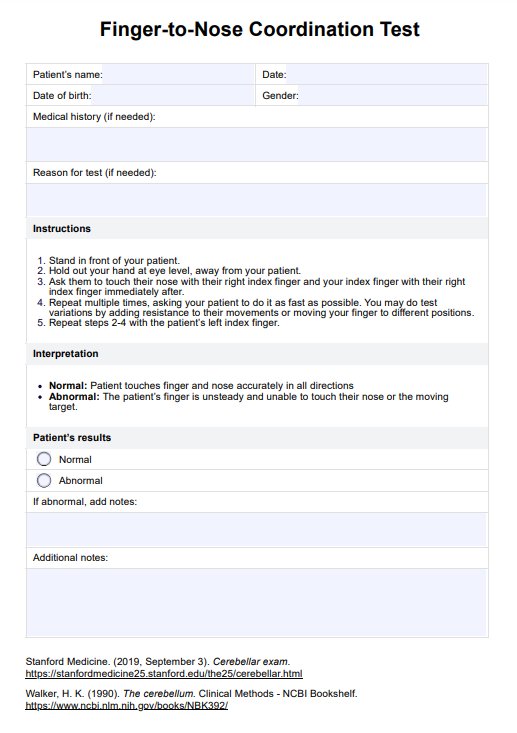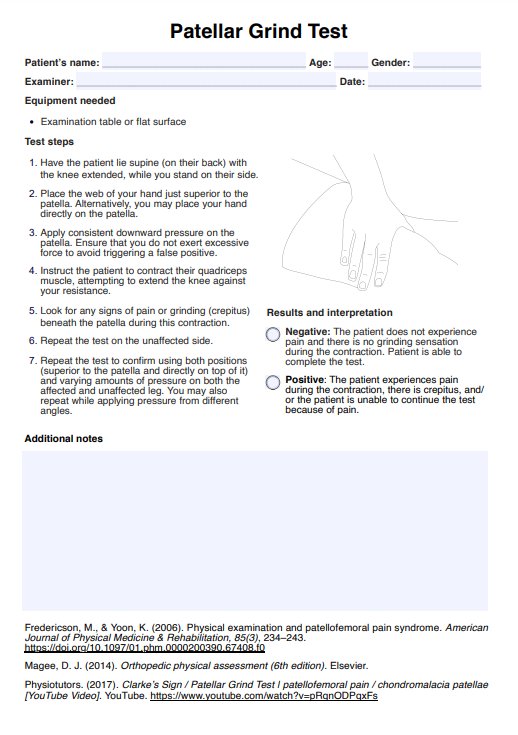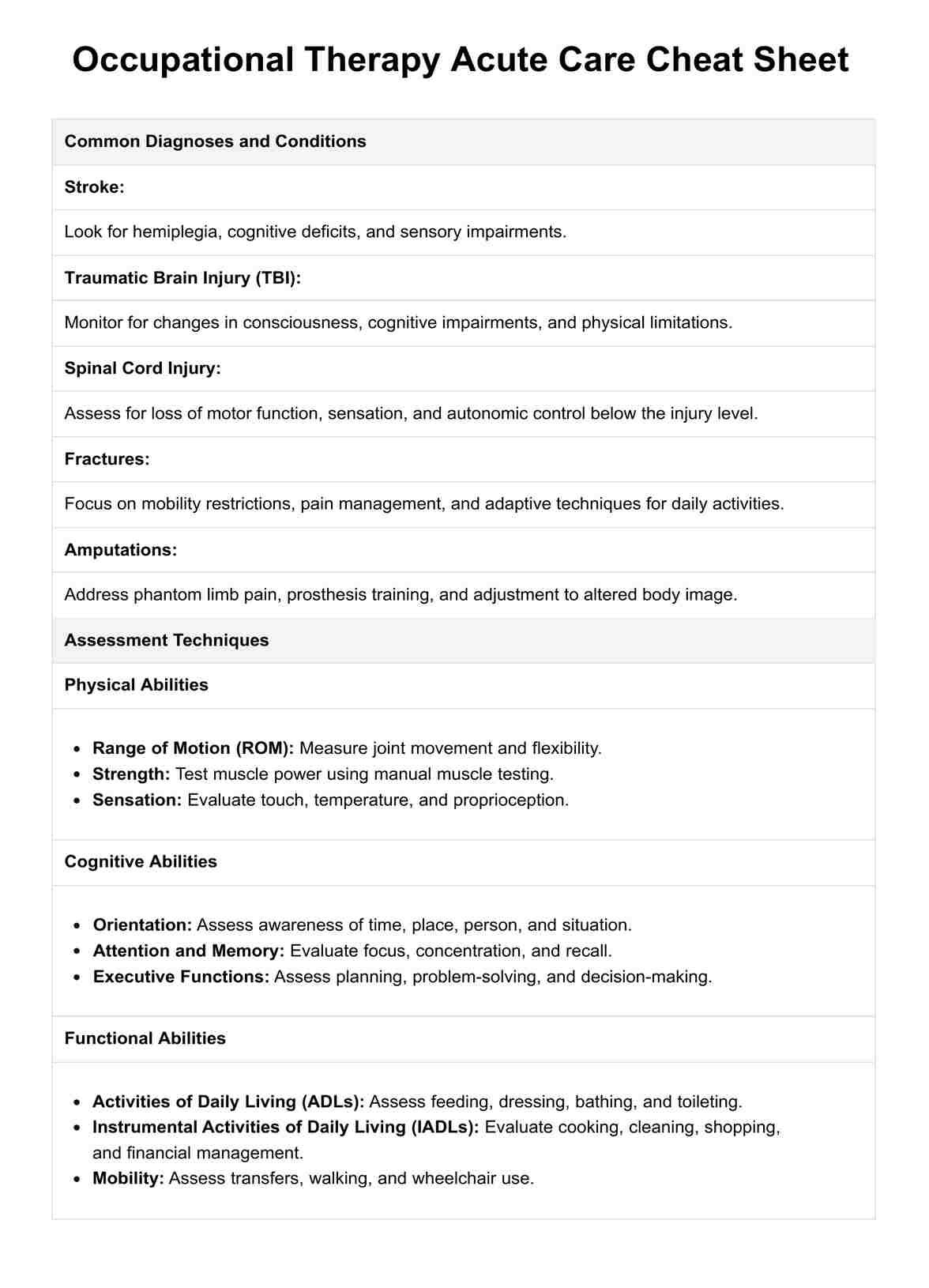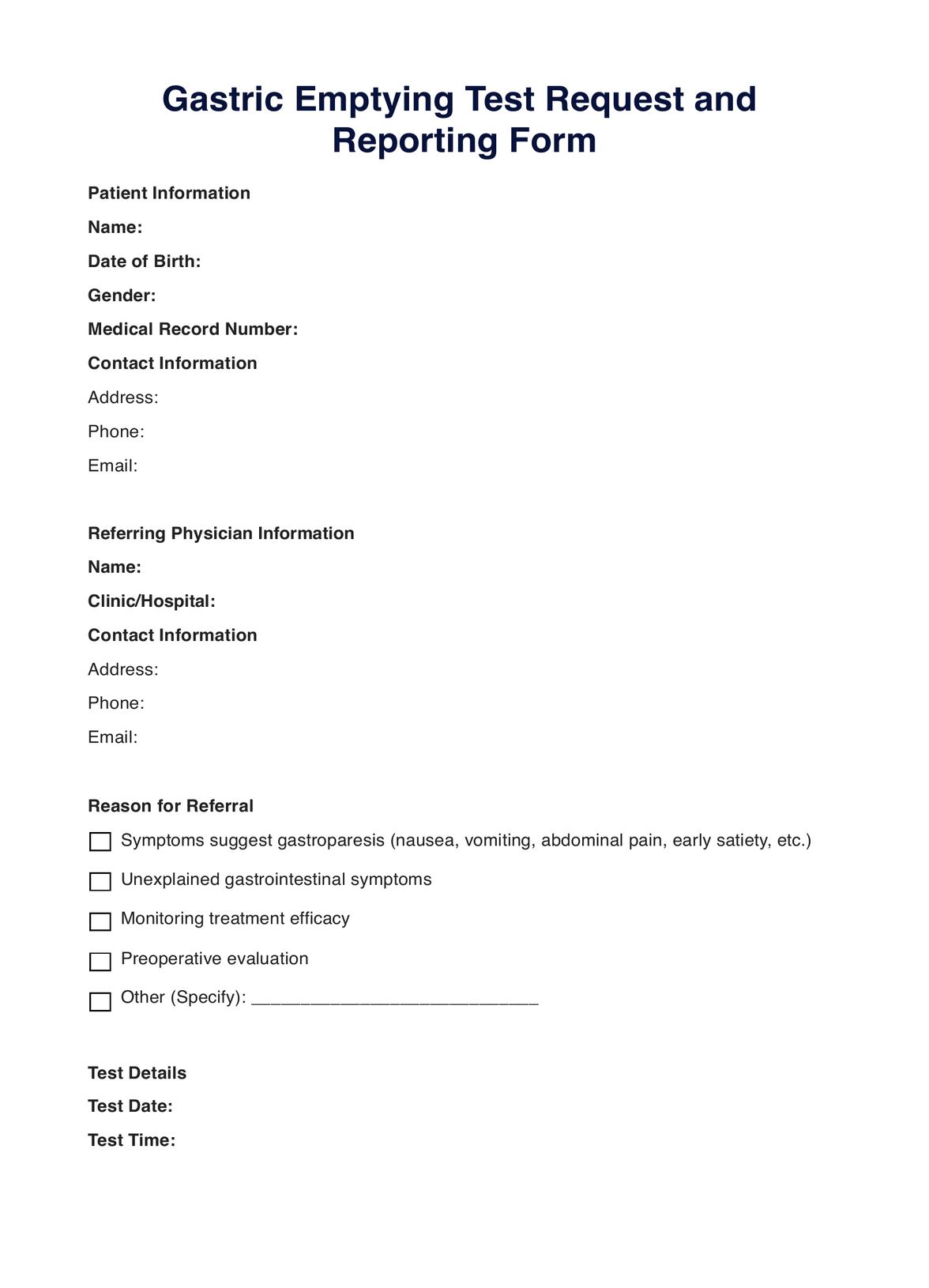Brief Pain Inventory
Discover the Brief Pain Inventory (BPI), a powerful tool for measuring pain intensity and its impact. Learn how it works and its benefits.


What Is a Brief Pain Inventory (BPI)?
If you work in healthcare, chances are you've encountered patients dealing with pain. Pain is one of the most common reasons patients seek medical attention, and it's crucial to assess and manage it accurately. That's where the ) comes in.
The BPI is a simple and widely-used tool for assessing pain severity and how it impacts a patient's life. It's a self-report questionnaire that asks patients to rate their pain intensity and how it affects their daily activities and mood. The BPI has been used in various settings, including hospitals, clinics, and research studies. It can be used with patients with all kinds of pain, from acute to chronic.
The BPI is a vital resource for healthcare providers because it provides valuable information about a patient's pain experience, which can inform treatment decisions and help healthcare providers better understand the impact of pain on their patients' lives. By using the BPI, healthcare providers can more accurately assess pain severity, monitor changes in pain over time, and evaluate the effectiveness of pain management strategies. Ultimately, using the BPI aims to improve patient outcomes and quality of life.
Check out this video on the Brief Pain Inventory and other pain assessment tools:
Brief Pain Inventory Template
Brief Pain Inventory Example
How Does This Brief Pain Inventory Work?
The Brief Pain Inventory (BPI) is a commonly used tool for measuring pain severity and its impact on daily activities. It is a simple yet effective questionnaire that patients can complete to provide healthcare providers with an accurate assessment of their pain levels. Here is a step-by-step guide on how to use the BPI:
Step 1: Introduce the BPI to the Patient
Explain to the patient the BPI, why it is essential, and how it will help you better understand their pain. Provide them with the questionnaire and ask them to read the instructions carefully before filling it out.
Step 2: Have the Patient Rate Their Pain
Ask the patient to rate their pain by marking the box beside the number that best describes their pain at its worst, least, on average, and right now.
Step 3: Ask About Pain Treatments
Inquire about any pain treatments or medications the patient receives and ask them to list them in the appropriate section of the questionnaire.
Step 4: Ask About Pain Relief
Ask the patient to rate how much relief pain treatments or medications were provided in the last 24 hours by marking the box below the percentage that best shows how much relief they received.
Step 5: Ask About Pain Interference
Ask the patient to mark the box beside the number that describes how much pain interfered with their general activity, mood, walking ability, normal work, relations with other people, sleep, and enjoyment of life during the past 24 hours.
Step 6: Review and Discuss the Results
Review the completed BPI with the patient, discuss their responses, and address any concerns or questions they may have. Use the results to develop a personalized pain management plan for the patient.
Remember that the Brief Pain Inventory tool is intended to help healthcare providers understand a patient's pain experience and provide appropriate pain management recommendations. It is vital to provide clear instructions to the patient and ensure they know the questions to assess their pain levels accurately.
When To Use a Brief Pain Inventory Short Form?
The Brief Pain Inventory (BPI) Short Form is commonly used to assess patient pain. It can be used in various healthcare settings and is appropriate for patients of all ages. It evaluates both acute and chronic pain and is particularly useful in monitoring the progression of pain over time. Here are some situations where it would be appropriate to use the BPI Short Form:
- In clinical settings: The BPI Short Form is often used to assess pain in patients with chronic conditions such as cancer, arthritis, and back pain. It is also helpful in assessing pain in patients who are recovering from surgery or other medical procedures.
- In research studies: The BPI Short Form has been used in numerous research studies to evaluate pain levels in participants. It is a reliable and valid measure of pain and is often used in clinical trials to assess the effectiveness of new pain treatments.
- In palliative care: The BPI Short Form is a valuable tool in palliative care settings where patients may be experiencing significant pain. It can assess pain management interventions' effectiveness and monitor pain levels over time.
The BPI Short Form is a versatile tool used in various healthcare settings. It is beneficial in assessing chronic pain and monitoring pain levels over time. The BPI Short Form can be administered quickly and easily, making it a practical tool in busy clinical settings.
Who Is This Brief Pain Inventory PDF For?
The Brief Pain Inventory (Short Form) PDF is designed for healthcare practitioners who work with patients experiencing pain. The following practitioners can use this tool:
- Physicians: The BPI can help physicians assess their patient's pain and its impact on their daily life. It can also help physicians monitor the effectiveness of pain treatments and adjust them accordingly.
- Nurses: Nurses can use the BPI to evaluate their patient's pain and provide appropriate interventions to help manage their symptoms. It can also educate patients and their families on pain management techniques.
- Physical Therapists: The BPI can help physical therapists assess their patient's pain levels and develop appropriate treatment plans to help manage pain during therapy.
- Palliative Care Specialists: The BPI is a valuable tool for palliative care specialists who work with patients experiencing chronic pain due to severe illnesses. It can help these specialists provide their patients with the most effective pain management interventions.
- Researchers: BPI is commonly used in research studies to evaluate the effectiveness of pain management interventions and to gather data on pain symptoms and their impact on patient's quality of life.
Overall, the Brief Pain Inventory (Short Form) PDF is a valuable resource for any healthcare practitioner who works with patients experiencing pain. It can help practitioners better understand their patient's pain levels and their impact on their daily life, leading to more effective pain management interventions and improved patient outcomes.

Benefits of Free Brief Pain Inventory Questionnaire
Saves Time and Effort
By using a pre-made template, practitioners can save time and effort in creating a pain inventory questionnaire from scratch, allowing them to focus on their patients' care.
Easy to Use
The brief pain inventory questionnaire is easy to use, making it convenient for patients and practitioners. Patients can quickly and easily provide information about their pain. At the same time, practitioners can quickly assess and track their patients' pain levels.
Provides a Comprehensive Pain Assessment
The questionnaire provides a comprehensive pain assessment, covering the different aspects of pain experienced by the patient, including its location, intensity, and how it affects their daily activities. This information can help practitioners identify the most appropriate treatment options for their patients.
Enables Tracking of Pain Progression
By using the questionnaire regularly, practitioners can track the progression of their patient's pain levels over time. This information can help practitioners adjust their patients' treatment plans to manage their pain better.
Facilitates Communication Between Patients and Practitioners
The questionnaire can facilitate better communication between patients and practitioners, allowing for a more collaborative approach to pain management. Patients can provide more accurate and detailed information about their pain. At the same time, practitioners can better understand their patient's pain levels and make more informed decisions about their care.
Improves Patient Outcomes
Practitioners can provide more targeted and effective pain management by using a comprehensive pain assessment tool like the brief pain inventory questionnaire, improving patient outcomes and quality of life.
Commonly asked questions
The Short Form is a more condensed version of the Long Form and is used to quickly assess pain levels and the impact of pain on daily activities, while the Long Form provides a more detailed analysis of pain experiences.
Yes, the Brief Pain Inventory can be used for all types of pain, including acute and chronic pain, and can help healthcare practitioners better understand and manage their patients' pain.
The frequency of administration of the Brief Pain Inventory depends on the patient's needs and circumstances. Depending on the patient's pain management plan, it can be administered as frequently as daily or weekly or as infrequently as every few months.


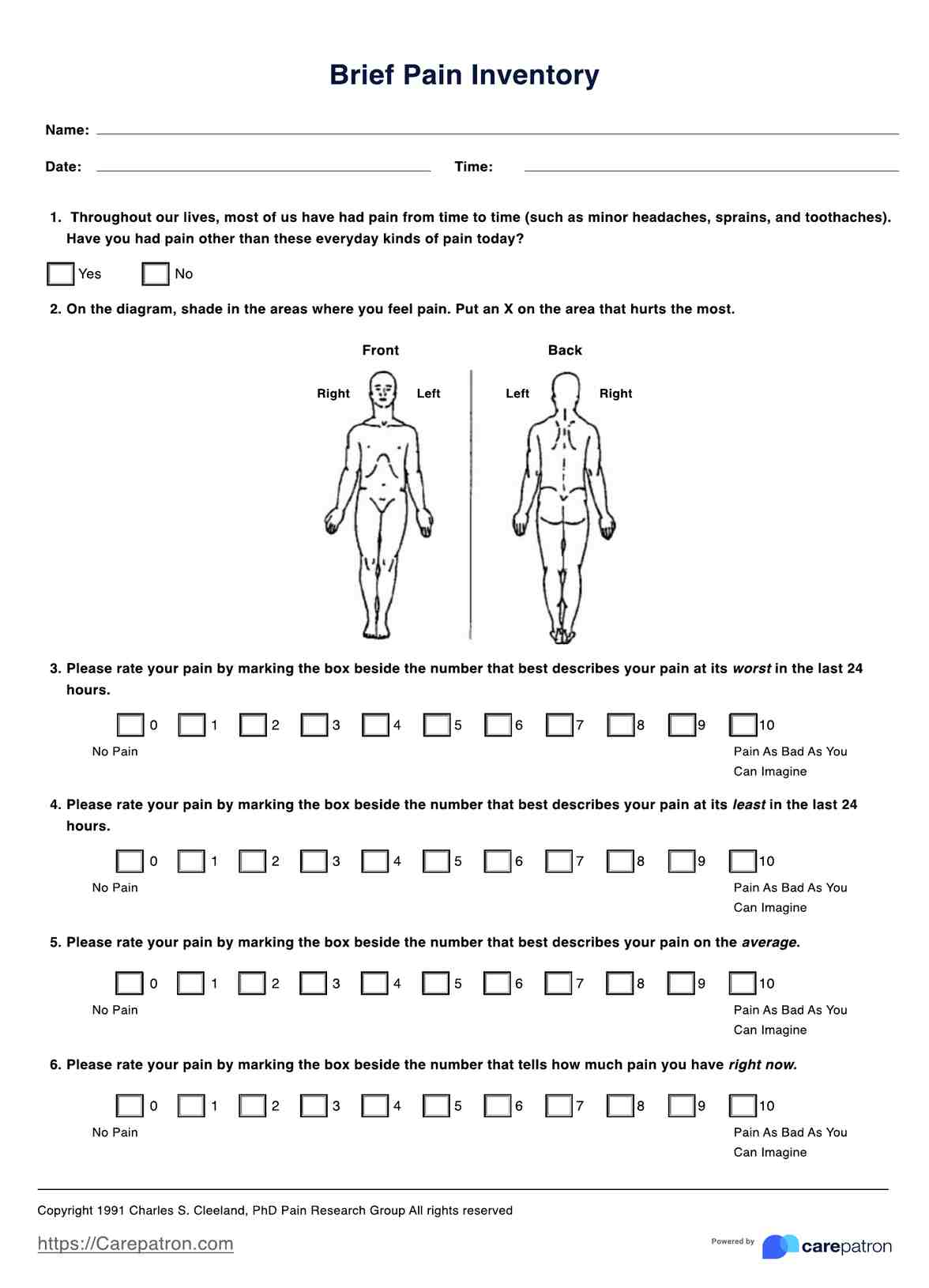
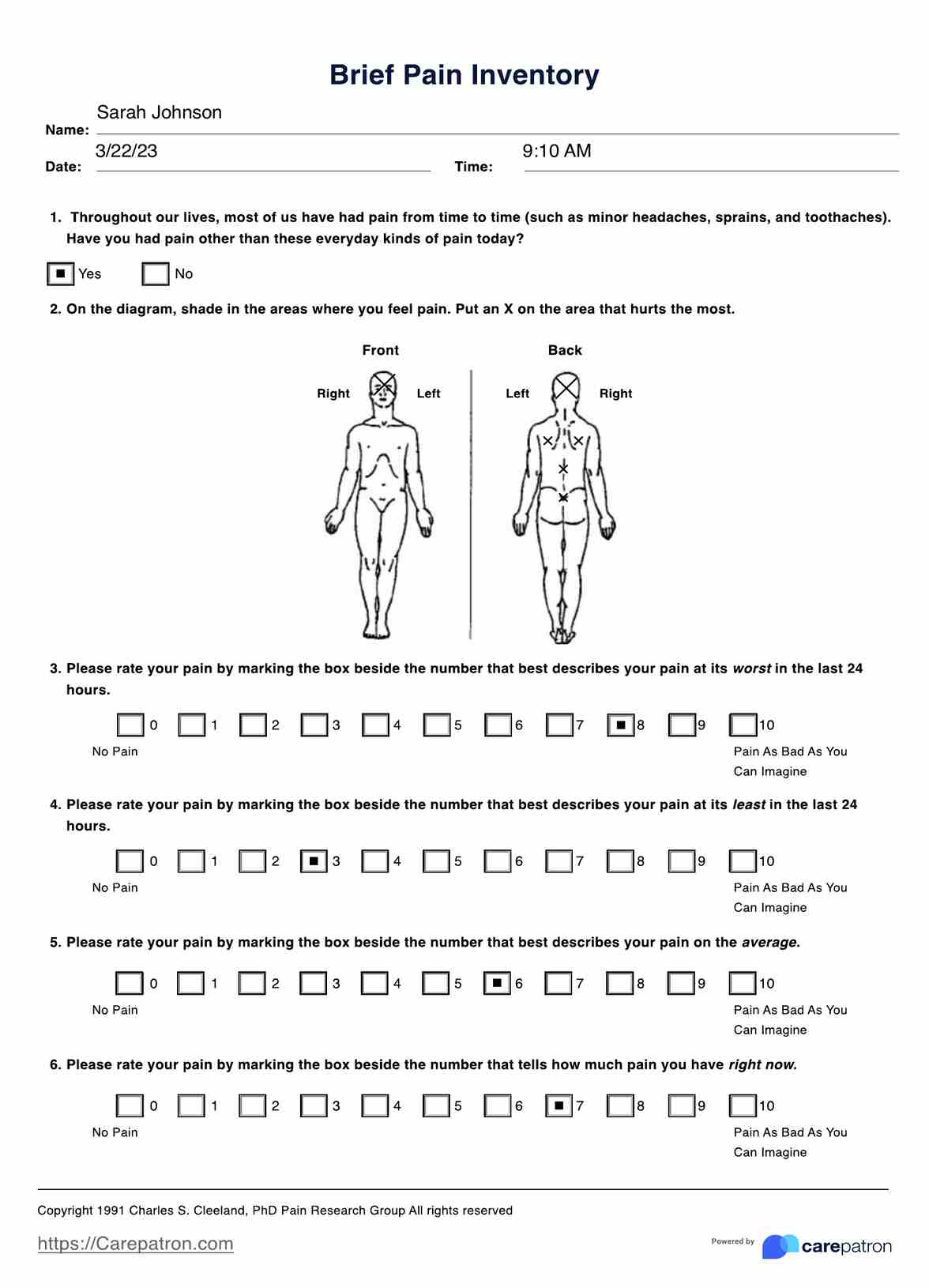

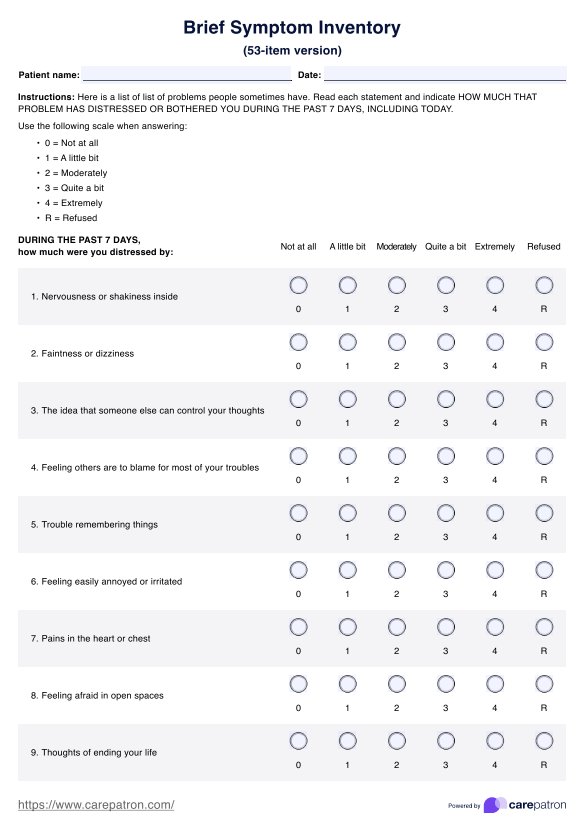

















-template.jpg)

















































































